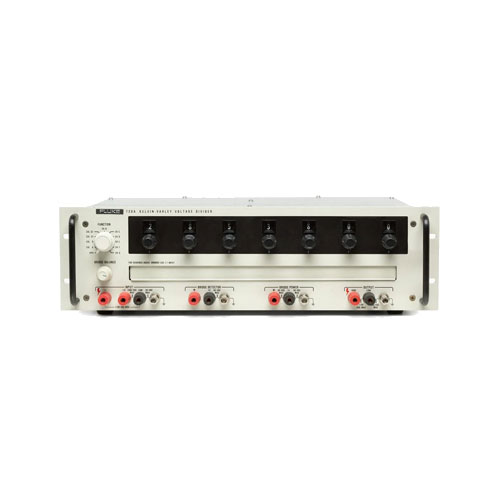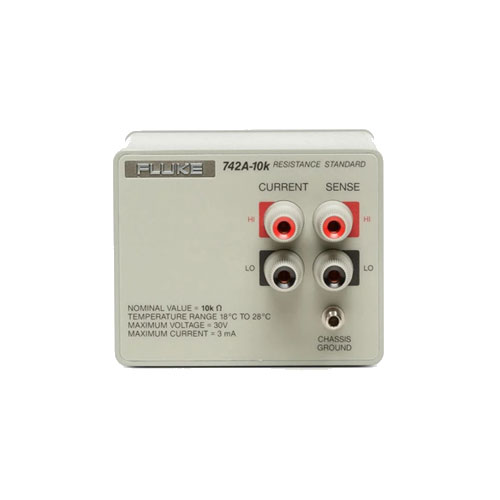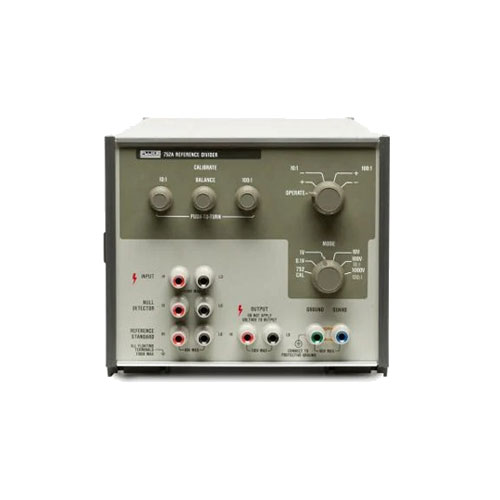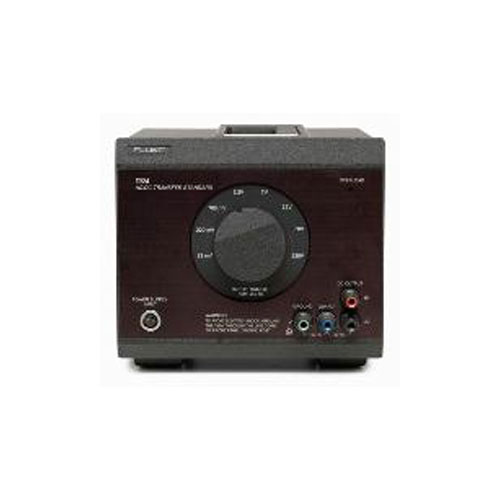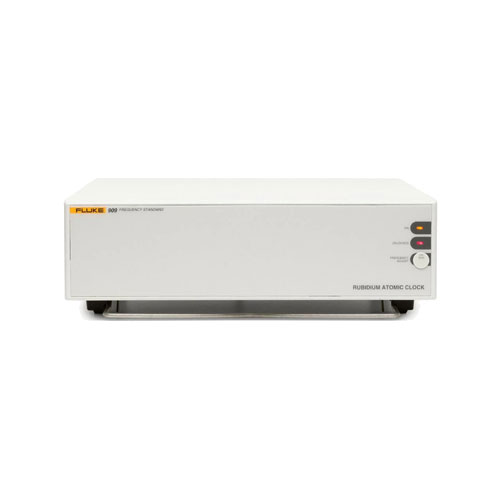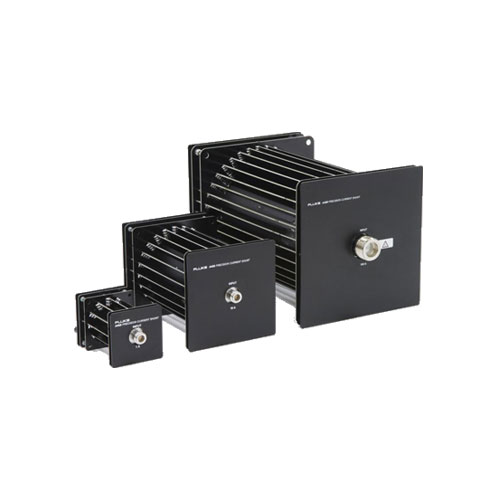Fluke 732C and 734C DC Voltage Reference Standards
- RoHS compliant, direct voltage reference designed to maintain the volt in primary and secondary standards laboratories.
- 10 V, 1 V, and 0.1 V outputs, and transportable to remote locations.
- Consists of four electrically and mechanically independent 732C DC Reference Standards.
- Traceable to national standards and to the Fluke Calibration 10 V Josephson Array.
- Description
- Additional information
- Specifications
Description
The Fluke 732C and 734C are high-accuracy DC voltage reference standards used in metrology laboratories to maintain and distribute the volt.
Fluke 732C:
- Individual Standard: A single, portable unit that provides highly accurate DC voltage outputs at 10 V, 1 V, and 0.1 V.
- Portability: Designed for easy transport to remote locations.
- Compact and Rugged: Small, lightweight, and built for durability.
- Fluke 734C:
- System of Standards: Consists of four independent 732C standards housed in a single rack-mount enclosure.
- Enhanced Stability: Provides improved stability and reduced uncertainty through intercomparisons between the four independent standards.
Key Features of Both Models:
- RoHS compliant, direct voltage reference designed to maintain the volt in primary and secondary standards laboratories.
- 10 V, 1 V, and 0.1 V outputs, and transportable to remote locations.
- Consists of four electrically and mechanically independent 732C DC Reference Standards.
- Traceable to national standards and to the Fluke Calibration 10 V Josephson Array.
- High Accuracy: Offer exceptional accuracy and stability for maintaining the volt.
- Traceability: Traceable to national standards and the Fluke Calibration 10 V Josephson Array.
- Reliability: Built with robust and reliable components for long-term performance.
- Ease of Use: User-friendly design simplifies operation and maintenance.
Applications:
- Maintaining the volt in primary and secondary standards laboratories.
- Calibrating high-accuracy voltmeters, multimeters, and other voltage measurement devices.
- Supporting research and development in metrology and other scientific fields.
In essence, the Fluke 732C and 734C are essential tools for metrology laboratories, providing the foundation for accurate voltage measurements and ensuring the integrity of the measurement chain.
Additional information
| Brand | Fluke Calibration |
|---|
Specifications: 732C and 734C DC Voltage Reference Standards
General Specifications
| Table 1. Mains | ||
| Line voltage is accepted as shown in Table 1. AC line current at 120V ac is typically 0.13A. | ||
| 732C Line Voltage Setting | Line Voltage Accepted | Frequency Accepted |
| 100 V | 90 V to 110 V | 50 Hz/60 Hz |
| 120 V | 108 V to 132 V | 50 Hz/60 Hz |
| 220 V | 198 V to 242 V | 50 Hz/60 Hz |
| 240 V | 216 V to 264 V | 50 Hz/60 Hz |
| Specifications | ||
| Battery | Battery Operation | At full charge, the internal battery operates the Product for a minimum of 72hours at 23±5 °C, with 0 mA to 0.1 mA total current drain at the outputs. |
| Charging Time | <36 hours with self-contained automatic battery charger | |
| External DC Input | Rear-panel input for external 12 V dc to 15 V dc powers the Product indefinitely. The dc source must be rated ≥300 mA. | |
| Isolation | Resistance from any of the Product binding posts to earth (chassis) ground or to ac line power is >10 000 MΩ shunted by <1000 pF. | |
| Guard and Ground Terminals | Chassis ground connections are provided on both the front and rear panels. Access to the internal guard is provided by a front-panel binding post. | |
| Output Protection | All outputs can be shorted indefinitely without damage to the Product. The 10 V output can withstand voltages from other sources as follows:
|
|
| Environmental | |
| Specified Operation | Temperature Range: 15 °C to 35 °C |
| Relative Humidity: 0% to 90% to 28 °C, to 80% to 35 °C, and to 50% to 50 °C, Noncondensing | |
| Altitude: 0 m to 1830 m (0 ft to 6000 ft) | |
| Non-specified Operation | Temperature Range: 0 °C to 50 °C |
| Relative Humidity: 0% to 90% Noncondensing | |
| Altitude: 0 m to 3050 m (0ft to 10 000ft) | |
| Storage (Battery Removed) | Temperature Range: -40 °C to 50 °C |
| Relative Humidity: Noncondensing | |
| Altitude: 0m to 12 200 m (0 ft to 40 000 ft) | |
| Electromagnetic Compatibility | |
| (EMC) The Product operates in Standards Laboratory environments where the radio frequency (RF) environment is highly controlled. | |
| International | IEC 61326-2-1; CISPR 11: Group 1, Class AControlled Electromagnetic Environment
Group 1 equipment has intentionally generated and/or use conductively coupled radio-frequency energy which is necessary for the internal functioning of the equipment itself. Class A equipment is equipment suitable for use in all establishments other than domestic and those directly connected to a low voltage power supply network which supplies buildings used for domestic purposes. Emissions which exceed the levels required by CISPR 11 can occur when the equipment is connected to a test object. The equipment may not meet the immunity requirements of 61326-1 when test leads and/or test probes are connected. |
| USA (FCC) | 47 CFR 15 subpart B, this product is considered an exempt device per clause 15.103 |
| Korea (KCC) | Class A Equipment (Industrial Broadcasting & Communication Equipment)This product meets requirements for industrial (Class A) electromagnetic wave equipment and the seller or user should take notice of it. This equipment is intended for use in business environments and not to be used in homes. |
| Safety | |
| Safety | IEC 61010-1, Installation Category II, Pollution degree 2 |
| Ingress Protection | IEC 60529: IP20 |
| Mechanical Specifications | ||
| 734C Dimensions | 732C and 732C-7001 Dimensions | |
| Height | 17.8 cm (7.0 in) | 13.4 cm (5.28 in) |
| Width | 43.2 cm (17.0 in) | 9.8 cm (3.85 in) |
| Depth | 50.3 cm (19.8 in) including handles | 40.6 cm (16.0 in) |
| Weight | 30.4 kg (67 lb) | 5.91 kg (13 lb) |
| Performance Specifications | |
| Output Voltages | 10 V, 1 V, and 0.1 V are provided at separate binding posts referenced to the VCOM binding post. |
| Stability | Stability for the 732C outputs at Tcal ±1 °C and IN CAL indicator on is specified in Table 2. Table 2. |
| Table 2. Standard Stability | |||
| Output Voltage | Stability (± µV/V) | ||
| 30 Days | 90 Days | 1 Year | |
| 10 V | 0.3 | 0.8 | 2.0 |
| 1 V | 0.6 | 1.2 | 3.0 |
| 0.1 V | 1.2 | 2.9 | 9.8 |
| Table 3. Select Stability | |||
| Output Voltage | Stability (± µV/V) | ||
| 30 Days | 90 Days | 1 Year | |
| 10 V | 0.3 | 0.8 | 1.0 |
| 1 V | 0.6 | 1.2 | 2.5 |
| 0.1 V | 1.2 | 2.9 | 8.0 |
| Noise at the Output Terminals | Output noise is specified for both day-to-day observations and for short-term observations, at k=1. | ||
| Table 4. Noise at the Output Terminals | |||
| Output Voltage | S1 (±µV/V) [1] | Sra (±µV/V) [2] | Noise (0.01 Hz to 10 Hz) (±µV/V rms) |
| 10V | 0.07 | 0.05 | 0.06 |
| 1 V | 0.16 | 0.14 | 0.15 |
| 0.1V | 1.4 | 1.3 | 1.0 |
| [1] S1 is the standard deviation about the regression (SDEV) of 90 days of at least twice daily stability test data. [2] Sra is the SDEV of the stability test data with a 7-day moving average filter (MAF). | |||
| To obtain the best performance, use the Product in controlled environments with good system grounding and shielding practices. For radiated EMI fields from 0.25 to 1 V/m from 80 to 130 MHz, add 9 µV to the 1 V output, and 3.6 µV to the 0.1 V output. For ac mains conducted EMI of 1 Vrms from 75 to 80 MHz, add 1 µV to the 1 V output, and 0.7 µV to the 0.1 V output. The 10 V output is mostly unaffected by EMI fields up to 1 V/m or by conducted EMI up to 1 Vrms. | |||
| Table 5. Output Current and Impedance | ||
| Output Voltage | Output Current Limit | Output Impedance |
| 10V | 12mA [1] | ≤1mΩ |
| 1V | 1.2mA [1] | ≤1mΩ |
| 100mV | 20pA | ≤100Ω |
| [1] Limit total output current to £0.1mA to realize specified battery operation | ||
| Table 6. Retrace (Hysteresis) Error | |
| Table 6 shows the change in 10V output voltage following a power outage (with the battery turned off) and temperature held constant in a 23 °C to 35 °C range | |
| Period that Power is Turned Off | Change in 10 V Output Value (±µV/V) |
| ≤10min | 0.1 |
| 10min to 24hr | 0.25 |
| 24hr to 14days | 0.25 |
| Stabilization Time Requirements | |
| Warmup times required after ac line and battery power have been turned off. The IN CAL indicator will be off, and recalibration will be necessary. The previously-specified retrace error specification can be used in the case of power interruptions. | |
| With no power interruption | No stabilization time is required after the Product is moved to another environment. |
| Power off for <1 hr | 1-hr warmup required |
| Power off for >1 hr | 24-hr warmup required |
| Table 7. Temperature Coefficient (TC) of Output | |
| From 15 °C to 35 °C, the temperature coefficient is bound by the information in Table 7. | |
| Output Voltage | Temperature Coefficient (±µV per V/°C) |
| 10 V | 0.04 |
| 1 V | 0.1 |
| 0.1 V | 0.2 |
| Table 8. Output with Altitude | |
| For an altitude change from calibration altitude, the output voltage change is bound by the information in Table 8. | |
| Output Voltage | Output Change (±µV/V per 1000ft) |
| 10 V | 0.05 |
| 1 V | 0.09 |
| 0.1 V | 0.18 |
| Load Regulation | |
| 10V Output Load Change | Maximum 10V Output Change (±µV/V) |
| 0 mA to 12 mA (no load to full load) | 1 |
| 0 mA to 2 mA | 0.1 |
| Line Regulation |
| The outputs will change no more than 0.05 µV/V for any 10% line voltage change or for the entire operating range of the battery |





















